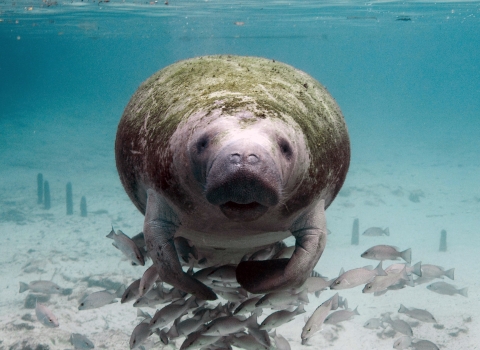They have quirky names and are often mistaken for stones, but freshwater mussels are very much alive and perform critical ecological functions in rivers and streams. We at the U.S. Fish and Wildlife Service have published a recovery plan to save four imperiled mussels protected under the Endangered Species Act: the rayed bean, sheepnose, snuffbox and spectaclecase.
The recovery plan for the four mussel species (PDF) focuses on protecting and enhancing populations through practices like captive rearing to restore key populations, managing and enhancing habitat, learning more about and alleviating threats to the species, and engaging the public and partners in freshwater mussel conservation.
Although mussels are often overlooked, they play a key role in keeping our waterways healthy. Not only do they filter sediments from water and keep the water clean, but their presence also tells us that our aquatic systems are healthy. On the other hand, their absence is a wake-up call that something is wrong in our environment.
All four species were listed as endangered in 2012 under the Endangered Species Act. All four were also listed as focal species included in the $62.5 million for Inflation Reduction Act Endangered Species Act Recovery Planning funding. Threats to these mussels include destruction or changes to their riverine habitat, including dam construction and channelization, along with impacts from pollution and invasive species invasive species
An invasive species is any plant or animal that has spread or been introduced into a new area where they are, or could, cause harm to the environment, economy, or human, animal, or plant health. Their unwelcome presence can destroy ecosystems and cost millions of dollars.
Learn more about invasive species . While these mussels can still be found in some of their original range, their abundance and occurrence has been greatly reduced.
Recovery planning is one step in a process to address threats to endangered and threatened species. Plans provide a road map for private, Tribal, federal and state cooperation in conserving listed species and their ecosystems. While a recovery plan provides guidance on how best to help listed species achieve recovery, it is not a regulatory document. Now that a recovery plan is finalized, recovery partners will outline specific actions to carry out the plan.
The rayed bean (Villosa fabalis) is a small mussel, measuring only about 1.5 inches. This species, once found in at least 115 streams, rivers and other waters, now occurs in only 37 streams and 1 lake in Indiana, Kentucky, Michigan, New York, Ohio, Pennsylvania, Tennessee and West Virginia, along with Ontario, Canada. The rayed bean lives up to 15 years.
Measuring up to 5.5 inches, sheepnose mussels (Plethobasus cyphyus) can live up to 30 years. They once occurred in 79 streams and rivers, including one canal, but are now found in 22 waterways in Alabama, Illinois, Indiana, Iowa, Kentucky, Minnesota, Mississippi, Missouri, Ohio, Pennsylvania, Tennessee, Virginia, West Virginia and Wisconsin.
Snuffbox mussels (Epioblasma triquetra) are small, growing to less than 3 inches and living up to 20 years. These mussels once inhabited at least 210 streams, rivers and other waters, but are now known to occur in only 85. Their current range includes Alabama, Arkansas, Illinois, Indiana, Kentucky, Michigan, Minnesota, Missouri, Ohio, Pennsylvania, Tennessee, Virginia, West Virginia, Wisconsin and Ontario, Canada.
Spectaclecase mussels (Cumberlandia monodonta) can reach 9 inches in length and live for more than 100 years. Once found in 61 rivers and streams, they now inhabit 40 waterways; populations have declined by an estimated 60 percent. They occur in Alabama, Arkansas, Georgia, Illinois, Iowa, Kentucky, Minnesota, Mississippi, Missouri, Ohio, Tennessee, Virginia, West Virginia and Wisconsin.



